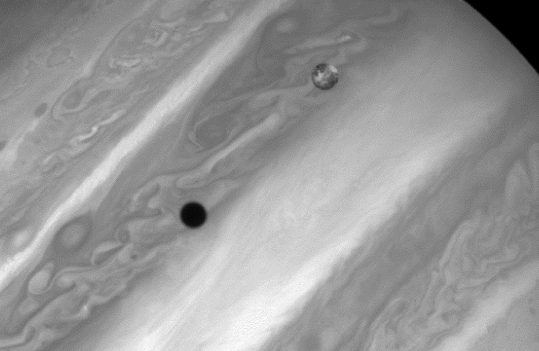Credit & Copyright:
J. Spencer (Lowell Observatory),
NASA
Explanation:
Caught in the act earlier this summer by the Hubble Space Telescope,
the volcanic moon Io
(above and right of center) and its shadow (black dot) are seen here against
Jupiter's clouds.
Io's shadow is 2,262 miles in diameter (about the size of Io)
as it races across the swirling cloud tops
at about 38,000 miles per hour.
From our perspective in the inner Solar System, dramatic scenes like this one
are possible when Jupiter, Io, and
the Sun line up.
What would this scene look like when viewed from Jupiter's cloud tops?
As the shadow passed over Jupiter, for observers along the shadow's track,
Io's disk would appear to eclipse the sun.
The situation is familiar to those Earth Dwellers
who have seen
a Solar Eclipse - visible from along the track of
the Moon's shadow passing across
the surface of the Earth.
1999 2000 2001 2002 2003 2004 2005 2006 2007 2008 2009 2010 2011 2012 2013 2014 2015 2016 2017 2018 2019 2020 2021 2022 2023 2024 2025 |
Январь Февраль Март Апрель Май Июнь Июль Август Сентябрь Октябрь Ноябрь Декабрь |
NASA Web Site Statements, Warnings, and Disclaimers
NASA Official: Jay Norris. Specific rights apply.
A service of: LHEA at NASA / GSFC
& Michigan Tech. U.
|
Публикации с ключевыми словами:
Ио - Юпитер - Солнечное затмение
Публикации со словами: Ио - Юпитер - Солнечное затмение | |
См. также:
Все публикации на ту же тему >> | |
